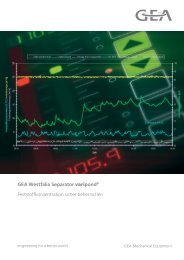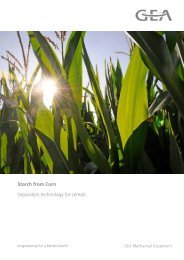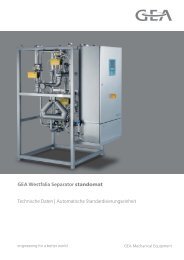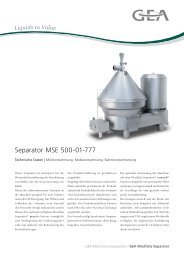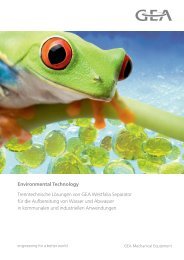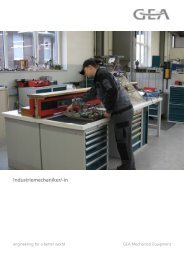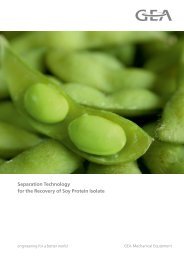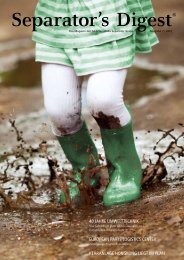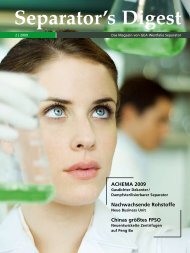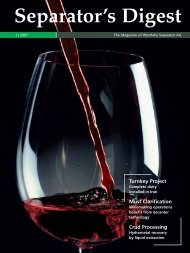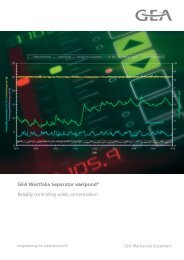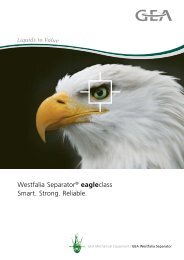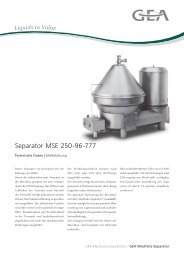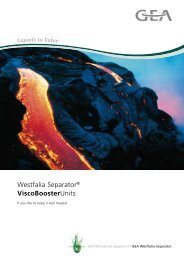Separator's Digest - GEA Westfalia Separator Group
Separator's Digest - GEA Westfalia Separator Group
Separator's Digest - GEA Westfalia Separator Group
You also want an ePaper? Increase the reach of your titles
YUMPU automatically turns print PDFs into web optimized ePapers that Google loves.
in peru, a country with an important fish<br />
industry, the government has introduced<br />
new environmental legislation, including a<br />
requirement for all companies in the fish<br />
meal industry to employ better treatment<br />
for effluent which is generated. since this<br />
year, this has been practiced very successfully<br />
by the largest fish meal manufacturer in the<br />
world, namely Technología de alimentos<br />
s. a. (Tasa), using a special decanter from<br />
Gea westfalia separator systems.<br />
Processing transport water<br />
fishing vessels discharge their haul directly<br />
into the factory from the vessel via large<br />
pipelines. sea water is used as the transport<br />
medium. when it is pumped through the<br />
pipelines, this transport water becomes<br />
contaminated with fish particles and fish<br />
oils. in its 17 fish meal factories in peru with<br />
a total capacity of around 250,000 tonnes<br />
of fish p. a., Tasa produces between 80 and<br />
150 tonnes fish / h. approximately three<br />
times this quantity of water is required for<br />
conveying the fish from the fishing vessel to<br />
the factory. This is equivalent to a pump<br />
water quantity of around 250 to 450 m³ / h<br />
in the various production facilities. Until<br />
several years ago, this pump water which<br />
contained oils, fats and solids, was<br />
discharged untreated into the sea. at the<br />
end of 2007, Tasa then installed a processing<br />
stage at its location in piscoica with<br />
a capacity of 140 tonnes fish / day; the main<br />
aim of this installation was to recover the<br />
oils, fats as well as the solids contained in<br />
the water so that they could be further<br />
processed in the production process. for<br />
this purpose, the pump water is initially<br />
floated in a daf unit (dissolved air flotation),<br />
and is then processed via two threephase<br />
decanters type Ucc 458. These machines<br />
separate the transport water into oils and<br />
solids, which can be further processed, as<br />
well as effluent.<br />
Second treatment stage<br />
however, the water remaining from this<br />
initial flotation process still contains excessive<br />
levels of oils and fats (3000 to 5000 ppm)<br />
and solids (8000 to 10,000 ppm). however,<br />
in its new legislation, the peruvian government<br />
has specified values of 1500 ppm oils<br />
and fats and 2500 ppm solids specifically for<br />
the fish meal industry. But this is not enough:<br />
in four years, these figures will be reduced<br />
further to 350 ppm (oils and fats) and<br />
700 ppm (solids). further effluent treatment<br />
using a second flotation unit was necessary<br />
<strong>GEA</strong> <strong>Westfalia</strong> <strong>Separator</strong> Systems 33<br />
<strong>Separator</strong>’s <strong>Digest</strong> 3 | 2008<br />
for this purpose, with subsequent effluent<br />
clarification using a twophase decanter.<br />
The focus is not on recovering the oils and<br />
fats; instead, the overriding objective is to<br />
ensure that the clarified phase has to be as<br />
clean as possible before being returned to<br />
the sea. for this purpose, Tasa employs<br />
type Ucd 755 decanters with new<br />
technology using polymer flocculants.<br />
New technology<br />
only with the introduction of the new<br />
technology was it possible for the 2phase<br />
decanter to be used for this application.<br />
with this technology, separation was<br />
increased from between 50 and 60 percent<br />
to between 95 and 98 percent. The solution<br />
functions as follows: the level of liquid in<br />
the decanter has an effect on the clarification<br />
performance. This socalled pond depth can<br />
be regulated by means of regulating rings<br />
in the discharge of the clarified liquid. if<br />
the aim is to achieve a high degree of<br />
clarification, the pond depth has to be<br />
changed. if an optimum pond depth is<br />
achieved, the turbulence in the settled solids<br />
is reduced, and there is an improvement in<br />
the caking of the oil which is still contained<br />
in the effluent to the solids as well as the<br />
settling behaviour of these solids.<br />
Legal requirements have<br />
been more than met<br />
with the installed decanter, Tasa is able to<br />
recycle a very clean centrate back into the<br />
second daf unit. in practice, the legal<br />
requirements are more than met. This<br />
extensive processing of the pump water in<br />
the peruvian fish meal factory can be<br />
transferred to the worldwide fish meal<br />
industry, specifically in south america and<br />
asia in order to minimise effluent discharge<br />
values and to protect the ocean, which is<br />
the basis for fishing and fish processing. in<br />
the next fishing season, there are plans for<br />
even more extensive trials with decanters in<br />
order to improve clarification even further.<br />
for a clean ocean.



